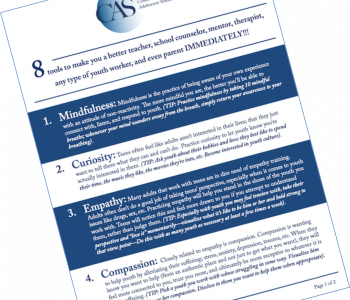

catharine hannay, ma
Catharine Hannay is the founder of MindfulTeachers.org and the author of Being You: A Girl’s Guide to Mindfulness, a workbook for teen girls on mindfulness, compassion, and self-acceptance.
3 Essential Tips for Working with Limited English Proficiency Youth
During a meeting at a refugee assistance organization, a psychologist described a problem she was having with one of her clients.
“I think he must be lying about how he got to the U.S.” she said. “I mean, given the rest of his story, how could he possibly have been in Iceland?”
The young man had asked for documentation that he was suffering from PTSD as a result of imprisonment and torture in his home country. But if he was lying about how he got to the United States, it was likely he was also lying about what happened to him and his reasons for seeking asylum.
At the meeting, the psychologists and social workers discussed how to tell when a client was telling the truth, and whether to confront him with the inconsistencies in his story.
As the only English teacher in the group, I had a completely different question.
“Are you sure he wasn’t mispronouncing ‘island’?”
I’m glad I asked! It turned out that was exactly what happened, and his time on an island was consistent with the rest of his account of the escape from his country. Once that was clarified, the psychologist saw no reason to doubt his story and was quite willing to sign the document he requested.
To put this another way, a traumatized youth could have lost his asylum status because a well-intentioned adult didn’t recognize a common pronunciation mistake.
While the stakes are rarely this high, this type of misunderstanding is all too common when working with non-native speakers of English, even with young people who appear to be fairly fluent. Many schools and social service agencies don’t have the time or funding to provide adequate training in working with these populations, and interpreters aren’t always available. While every situation is different, you can cut down considerably on miscommunication and frustration if you follow these suggestions for talking with Limited English Proficiency youth.
1) Learn as much as you can about the typical sources of confusion.
If you work with a lot of young people from the same country or region, it’s worth spending at least a few hours reading about their language and culture. In addition to helping avoid misunderstandings, this goes a huge way toward establishing your credibility and good will.
Of course, this is much harder if your clients come from a wide range of backgrounds. Here are some typical communication issues for non-native speakers of English from all over the world:
- Speaking Too Quickly: If you’re talking to a youth who doesn’t seem to understand what you’re saying, the first thing to try is slowing down. Enunciate clearly, and leave a brief pause between sentences.
- Not Leaving Enough Time for a Response: It’s also very common for an adult to ask a question and expect an immediate answer. In a second language, it can take a minute or two to process what’s being asked and articulate a response.
- Pronunciation: As with the island/Iceland example, there are all sorts of words in English that don’t sound the way they’re spelled. You might try writing down part of your conversation, or reading a document out loud.
- Conditionals: You may need to be more direct in your phrasing. I try to avoid using expressions like “If I were you, I would do X,” which can be understood as “I [the adult] will do X.” It’s much clearer to say “I think you should do X,” or “Please do X.”
- Asking ‘Do you understand?’: Heads nodding? Doesn’t necessarily mean they understand. Saying ‘yes,’ or repeating the word ‘understand’? Still not a guarantee. If you want to make sure they really do understand and aren’t just being polite, you can say something like “Please tell me in your own words what you need to bring with you to your next appointment.”
2) Take a brief pause from a frustrating or confusing encounter.
Most of us have far more work than we can possibly get done in a given day. Taking a mini break in the middle of meeting with a student or client may seem like totally unrealistic advice. Actually, it can end up saving time, because it can shift your perspective enough to help you figure out a more effective way to communicate.
The next time you’re in a tense situation with a non-native English speaker, try ‘T.A.P.,’ a relational mindfulness practice developed by Dr. Sam Himelstein.
Take a breath. Acknowledge. Proceed (TAP).
Take a breath.
In the midst of any challenging encounter, it can be helpful to pause and simply breathe. This instantly calms you down, so you can think more clearly about what’s happening and the best way to respond.
Acknowledge.
After you’ve taken a couple of deep breaths, spend a few seconds silently recognizing both the situation and your reaction to it. For example, ‘I’m annoyed.’ Or ‘I feel disrespected.’
In addition to acknowledging your own experience, it’s helpful to remember that your students or clients are doing the best they can, and the more stressed they feel, the harder it is for them to communicate in a second language.
Proceed.
Once you’ve taken a few seconds to breathe and to acknowledge what’s happening, you’re ready to go ahead and deal with the situation.
If you can do this gently, it might help to start by acknowledging your feelings to the youth you’re working with. For example, “I think we both feel frustrated.”
If my students don’t know the word ‘frustrated’, I explain that it means someone wants something but can’t get it. I act out the idea for them by tightening my face and body so I look stressed, and I show the fingers of one hand trying to walk across the table but getting blocked by my other hand. It’s often a relief to the youth that someone understands how they’re feeling, and that improves the atmosphere considerably.
Now it’s time to make a new attempt at communicating.
Here’s a real-life example of how this can work:
A program assistant was caught in an infuriating conversation with a student.
“You have to pay your registration fee today.”
“Is OK. I pay you tomorrow.”
“You can’t pay me tomorrow. The deadline is today.”
“But I pay you tomorrow.”
“I just said that you have to pay me today. I need your money right now.”
“But I pay you tomorrow!”
“You can’t pay tomorrow. You have to pay today!”
By this point, with the assistant and the student both on the verge of tears, there was no point in repeating the same dialogue over and over. But what could she do?
She took a deep breath, acknowledged that they were both feeling frustrated, and decided to enlist one of the ESL teachers to help explain the policy. After hearing the two sides of the story, the teacher only had to say one word to resolve the situation:
“Yesterday?”
Sudden enlightenment.
“Have you been trying to tell me that you already paid yesterday?”
“Yes-ter-day. I pay you yesterday.”
“Let me look at the list. Yes, I see your name right here.”
3) Don’t be too quick to take offense.
“You need to teach your kids to be more polite,” the guidance counselor told me. “One of them sent me an email demanding an appointment!”
“Really?!” I had a particularly sweet class that semester, so I was surprised any of them had been so rude. “Which student did that?”
As soon as I heard the girl’s name, I understood. She was a native French speaker who’d translated ‘demande de rendez-vous’ as ‘demand for appointment’ rather than ‘request.’
The guidance counselor was still outraged by this unintended rudeness, even after I explained what happened and my student apologized.
“What will happen when she goes to college and sends messages like that to her professors? It’s totally unacceptable.”
The girl intended to be polite.
She was mortified when she realized how her message came across.
She won’t make that mistake again.
Let it go.
After all, this wasn’t nearly as bad as when I was studying in France and kept using an expression I thought meant “I don’t mind either way” but was actually a lot closer to “I don’t give a ______.” Not to mention what I did the day I arrived for a teaching assignment in Japan: I somehow managed to invite myself out for sushi with the president of the university!
More often than not, apparent rudeness is caused by misunderstanding something in the language or culture. It can be incredibly stressful and challenging attempting to communicate in a second language, especially with someone in a position of authority. Try to keep a sense of humor when young people do or say something unintentionally rude, and gently correct anything egregious so they don’t make the same mistake in front of someone less sympathetic.
Especially if you work with youth from a variety of backgrounds, you can’t predict every single communication issue that might arise. But you can follow the tips outlined above: learn as much as you can about typical sources of confusion, remain as calm as possible, and give your students or clients the benefit of the doubt that they aren’t intending to be difficult. If you can do those three things, you’ll have far fewer communication problems, and you’ll be in a much better position to establish an authentic relationship with your students or clients.
—
Catharine Hannay (MA TESOL, MS Communications) has twenty years of experience teaching non-native speakers of English, including a dozen years at Georgetown University’s Center for Language Education and Development. She is the creator and editor of MindfulTeachers.org, which provides free resources on mindfulness and self-care for educators and other helping professionals.
To gather with a dynamic and intentional community of helping professionals dedicated to networking across professions and coming together to provide trauma-informed and build authentic relationship with both colleagues and those we provide services to, join the FREE Training Community. Learn more and sign up here. It takes just 2 minutes!
Related Posts
4 Tips for Culturally-Sensitive Teaching
Add a Culturally-Aware Lens to Your Trauma-Informed Toolkit

